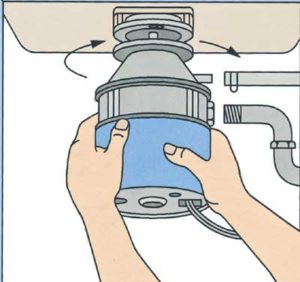Garbage Disposal Repair and Replacement
Garbage Disposal Repair and Replacement
 When your garbage disposal makes kitchen cleanup a chore instead of a breeze, you may need to repair it. An appliance repair person, plumber or handyman can fix some issues, but you might have to consider garbage disposal replacement.
When your garbage disposal makes kitchen cleanup a chore instead of a breeze, you may need to repair it. An appliance repair person, plumber or handyman can fix some issues, but you might have to consider garbage disposal replacement.
The garbage disposal are only designed to handle light food residue that is rinsed from plates and cooking utensils before they go into the dishwasher.
Scraps of food comprise between 10% and 20% of the average household waste. There has been an increasingly problematic issue associated with the disposal of leftover food, as it relates to, municipal waste disposal, public health concerns, sanitation and environmental problems. If you treat food waste as a liquid (since it is roughly 70% water), then modern wastewater plants can more effectively process the organic solids, which is an environmental boost. This also minimizes the amount of waste that will eventually end up in the landfill, decomposing and generating methane gas. Methane gas is thought to be a major contributor to global warming and is some twenty-one times more toxic carbon dioxide.
Basic Garbage Disposal Care
Garbage disposals work best if you follow these basic rules:
- Use cold water when grinding food (hot water can melt fats and clog the mechanism and the pipes)
- Do not overfill
- Do not pour bleach, drain cleaners, or other chemicals into the unit
- Do not grind overly fibrous materials, bones, or coffee grounds (check the owner’s manual) or such materials as glass, metal, or rubber
- Run water before and after you use the disposal If something has been put in the disposal that should not have been, use tongs or pliers to pull the material out. Never use your hand. To clean a garbage disposal of built-up sludge and debris, fill it with ice cubes and a cup of rock salt and then run it for about five seconds. If your garbage disposal smells bad, you can deodorize it by running warm water down it while you grind a quartered lemon.
How to Clean Your Garbage Disposer
Foul odors can occur from a buildup of food debris within the disposal. Try these steps to eliminate the odors: 
• Grind ice cubes and orange or lemon rinds in the disposer for about 30 seconds
• While the disposer is still running, pour a small amount of liquid dish detergent into it
• Rinse any remaining debris away by running cold water for about 30 seconds
Types of Garbage Disposal Leaks
Leak at the Sink Flange
- Turn off power to the disposal at the electrical service panel.
- At the disposer mount, turn the disposal to the left (counter-clockwise from bottom) to loosen and remove the unit from the mounting flange.
- Tighten the three mounting bolts.
- If the bolts are tight, the leak may be caused by failed plumbers putty. Loosen the bolts and push the sink flange slightly above the surface of the sink.
- Force plumbers putty between the sink flange and the sink, going completely around the flange.
- Tighten the mounting bolts drawing the sink flange tight to the sink surface. The putty will ooze out. Wipe away excess putty.
- Reinstall the disposal and turn the power back on at the service panel.
- Check for leaks.
Leak at the Dishwasher Connection
- Tighten the clamp on the dishwasher hose connected to the dishwasher inlet on the disposer.
- Replace the hose if the hose is leaking.
Leak at the Discharge Drainpipe
- Check the bolts holding the discharge pipe to the disposal for tightness.
- If that does not work, remove the bolts and the pipe and replace the gasket.
- Reinstall bolts and tighten.
